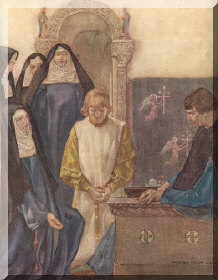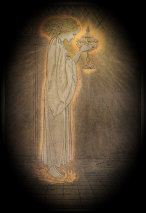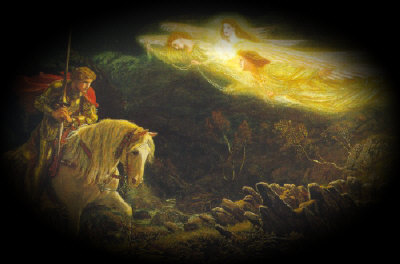Chapter VII:
The Quest for the Holy Grail
The Holy Grail has become a central theme in Arthurian literature. Some historians have traced its association with Arthur as far back as some of the earliest legends about him. But the Grail first began to shine as a major Christian symbol in the twelfth and thirteenth centuries, particularly with the circulation of the Vulgate Cycle, written by an unknown author.
 On the eve before Pentecost, a beautiful woman came to Arthur's castle, and asked Lancelot to follow her
into the forest. Lancelot, always the chivalrous knight, agreed, and the two went out. They rode until
they came to a nunnery. As they entered it, Lancelot saw that two of his cousins, Sir Bors and Sir Lionel,
were already there. Then the nuns brought out a young man and asked Lancelot to knight him. Lancelot
agreed, and the youth was knighted. The next day, as he and his cousins were riding back to Arthur's
castle, Sir Bors remarked that the young man had looked so much like Lancelot, it must have been his son
by Elaine.
On the eve before Pentecost, a beautiful woman came to Arthur's castle, and asked Lancelot to follow her
into the forest. Lancelot, always the chivalrous knight, agreed, and the two went out. They rode until
they came to a nunnery. As they entered it, Lancelot saw that two of his cousins, Sir Bors and Sir Lionel,
were already there. Then the nuns brought out a young man and asked Lancelot to knight him. Lancelot
agreed, and the youth was knighted. The next day, as he and his cousins were riding back to Arthur's
castle, Sir Bors remarked that the young man had looked so much like Lancelot, it must have been his son
by Elaine.
When Lancelot returned to Camelot, the knights were all summoned to meet at the Round Table. As he took his seat, he saw that there was now an inscription above the Siege Perilous. It read:
“Four Hundred and Fifty Years Have Passed Since The Passion Of Our Lord Jesus Christ: And On The Day Of Pentecost This Seat Shall Find Its Master.”
As their meeting began, an elderly knight entered the hall. With him was the young man Lancelot had knighted the evening before. He was Galahad, Lancelot's son by Elaine. He took his rightful place at the Siege Perilous.
Shortly later, an image of the Holy Grail appeared, floating over the table. It was a sign. It was time for Arthur and his knights to seek out the Grail.
In the adventure that followed, Galahad quickly proved himself to be the greatest knight of all time. Whereas his father had been charismatic and charming, Galahad was pure of heart, and refrained from much temptation in order to pursue more heavenly ideals.
Many of Arthur's knights sought out the Grail, but most returned badly wounded, or worse. Then three knights went out in search of it: Sir Bors, Sir Perceval, and Sir Galahad. They traveled to Corbenic by ship to seek out Galahad's grandfather, King Pellés.
 When the knights arrived, they were met by a host of Galahad's family from Elaine's side. Then, King
Pellés brought out a sword that had been broken in three pieces. When Galahad held them, the sword
became whole again. It was a sign. Galahad was given a vision, and he was shown wonders beyond any mortal
men can imagine. When he came out of his trance, he knew what had to be done.
When the knights arrived, they were met by a host of Galahad's family from Elaine's side. Then, King
Pellés brought out a sword that had been broken in three pieces. When Galahad held them, the sword
became whole again. It was a sign. Galahad was given a vision, and he was shown wonders beyond any mortal
men can imagine. When he came out of his trance, he knew what had to be done.
The Grail was in Britain, he said. But Camelot was unworthy of it. The knights were to take the Grail to the holy city of Sarras in the Middle East, to fulfill God's will.
When the three knights returned to their ship, they found the Grail already waiting for them there. They took it to the city of Sarras, just as they had been instructed. There, a great light appeared in the sky, and the Grail was lifted up into Heaven, forever beyond the reach of men.

Of the three knights who had ridden out in search of the Grail, only Sir Bors returned to Camelot to tell of what had happened. For Sir Perceval was moved by all he had seen, and chose to live out the remainder of his days as a hermit living in the forests outside Sarras. And Sir Galahad, having seen his vision of the Grail, died shortly after. For he gave up his life so he could remain pure.

